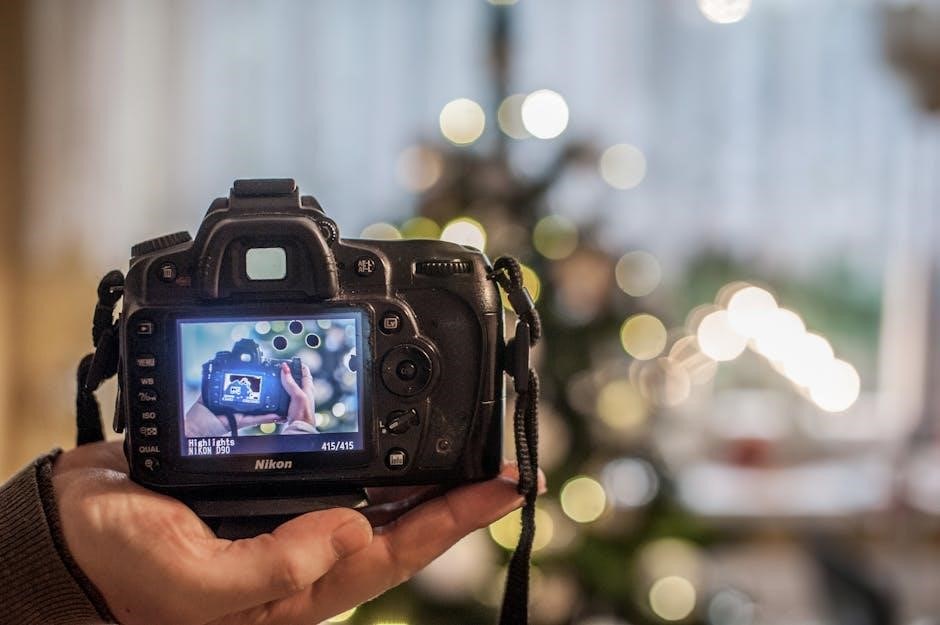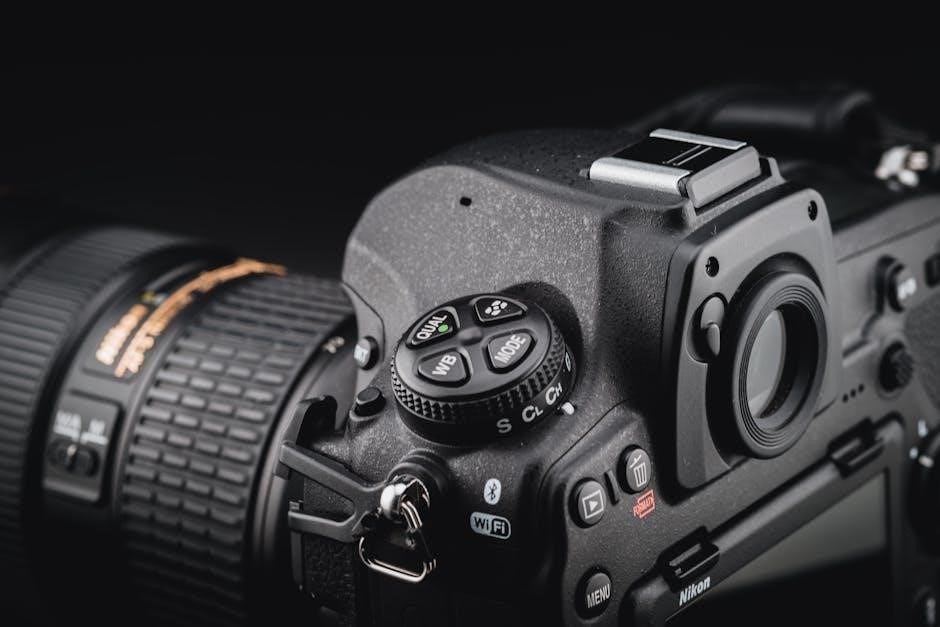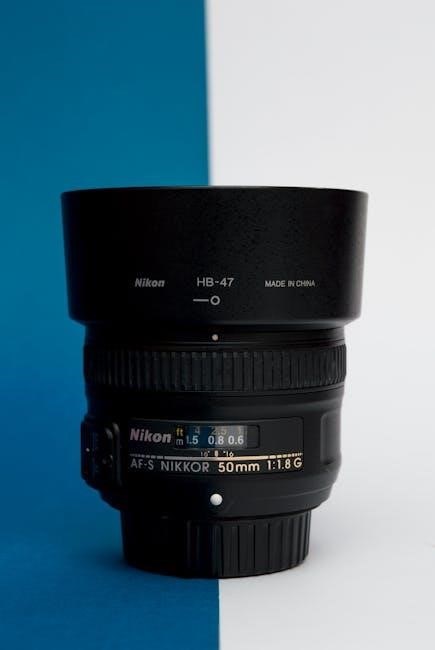
This manual provides a comprehensive guide to understanding and mastering the Nikon D5200 DSLR camera. It covers essential features, setup, and advanced techniques for optimal photography and video recording. The manual is divided into two parts: a User Manual for basic operations and a Reference Manual (PDF) for detailed settings and customization. By following this guide, users can unlock the full potential of their camera and enhance their creative photography skills.
Overview of the Nikon D5200
The Nikon D5200 is an entry-level DSLR camera featuring a 24.1MP APS-C sensor, full HD video recording, and a vari-angle 3-inch LCD screen. Designed for photography enthusiasts and hobbyists, it offers a balance of automatic and manual controls, making it ideal for both beginners and experienced photographers. Its compact design and intuitive interface provide easy access to creative modes and settings.
Key Features of the Nikon D5200
The Nikon D5200 boasts a 24.1MP DX-format CMOS sensor, delivering high-quality images with excellent low-light performance. It includes a 39-point autofocus system, 1080p HD video recording, and built-in HDR. The camera supports various shooting modes, including Scene, Program, Aperture Priority, Shutter Priority, and Manual modes. Its compatibility with a wide range of NIKKOR lenses and accessories enhances versatility for diverse photography needs.
Target Audience for the Nikon D5200
The Nikon D5200 is designed for photography enthusiasts and entry-level DSLR users seeking high-quality images and versatility. It appeals to hobbyists, students, and those transitioning from point-and-shoot cameras to more advanced photography. The camera’s user-friendly interface and robust features make it ideal for capturing various styles, from fine art to street photography, offering both basic and advanced customization options;

Understanding the Camera Components
The Nikon D5200 features external controls, a mode dial, and compatible lenses and accessories. These components work together to enhance photography experiences and customize camera operations effectively.
External Controls and Buttons
The Nikon D5200’s external controls and buttons are designed for intuitive operation. The mode dial offers quick access to shooting modes, while buttons like ISO, white balance, and live view enable easy adjustments. Customizable buttons allow personalized control, streamlining workflows for photographers. These features ensure efficient navigation and precise camera adjustments, enhancing overall user experience and creative control.
Mode Dial and Shooting Modes
The Nikon D5200’s mode dial offers a range of shooting options, from fully automatic to manual control. Auto Mode simplifies photography for beginners, while Scene Modes cater to specific situations like portraits, landscapes, and close-ups. Program Mode (P) balances aperture and shutter speed, while Aperture Priority (A), Shutter Priority (S), and Manual Mode (M) provide advanced control for experienced photographers. This versatility ensures adaptability for various photography needs.
Lens and Accessories Compatibility
The Nikon D5200 is compatible with a wide range of Nikon F-mount lenses, including AF-S, AF, and AI-S lenses, ensuring versatility for various photography needs. It also supports accessories like the MB-15 battery grip and WU-1a wireless adapter for enhanced functionality. Compatibility with third-party lenses and accessories is possible, though it’s recommended to check Nikon’s official compatibility chart for optimal performance.

Nikon D5200 User Manual Basics
The Nikon D5200 User Manual provides essential guidance for operating the camera, covering basic controls, shooting modes, and troubleshooting. It includes a printed User Manual and a detailed Reference Manual in PDF format, ensuring users can master both fundamental and advanced camera functions effectively. Reading the manual is crucial for optimal camera performance and understanding its full potential.
Where to Find the User Manual
The Nikon D5200 User Manual is available on Nikon’s official website as a downloadable PDF. It can also be accessed via the Nikon Manual Viewer 2 app for mobile devices. Additionally, the manual is included on a CD provided with the camera and is available in multiple languages. The Reference Manual (PDF) offers detailed instructions for advanced settings and troubleshooting, ensuring comprehensive guidance for users.
Reference Manual (PDF) Explanation
The Reference Manual (PDF) provides in-depth details on advanced features, custom settings, and troubleshooting for the Nikon D5200. It is accessible via the provided CD or Nikon’s official website. The manual requires Adobe Reader for viewing and offers comprehensive guidance for optimizing camera performance, including detailed explanations of shooting modes, firmware updates, and video recording settings to enhance user experience.
Importance of Reading the Manual
Reading the Nikon D5200 manual is essential for mastering its features and optimizing performance. It provides detailed guidance on setup, shooting modes, and troubleshooting, helping users avoid common mistakes. The manual also explains advanced settings and customization options, ensuring you get the most out of your camera. Investing time to read it will significantly enhance your photography experience and skills.
Setting Up the Camera
Initial setup involves inserting the battery and memory card, mounting the lens, and configuring basic settings. Proper setup ensures optimal performance and functionality for photography.
First-Time Setup Guide
For initial setup, insert the battery and memory card, ensuring they are securely locked in place. Mount the lens by aligning the white dots and twisting gently. Power on the camera and navigate through the menu to set language, date, and time. Perform a quick sensor cleaning if needed and update firmware for optimal performance. Proper setup ensures smooth functionality and readiness for photography.
Inserting the Battery and Memory Card
Open the battery compartment on the bottom of the camera. Insert the EN-EL14 battery, ensuring the terminal contacts align correctly. Close the compartment securely. For the memory card, slide it into the SD card slot on the right side until it clicks. Use a compatible SD, SDHC, or SDXC card for optimal performance.
The camera supports single card use. Always format the card in the camera before use to prevent data errors and ensure compatibility. Properly inserted cards and batteries are essential for camera functionality and image storage. Follow these steps carefully to avoid damage or operational issues.
Mounting the Lens and Basic Operations
To mount the lens, align the lens mounting mark with the camera’s mark. Gently rotate and lock into place. Ensure the lens is securely attached to avoid damage. After mounting, set the camera to Manual mode via the Mode Dial for creative control. Use the command dial to adjust aperture and shutter speed, optimizing settings for your desired shot. Proper lens mounting and basic operations are essential for capturing high-quality images with the Nikon D5200.
Shooting Modes and Settings
The Nikon D5200 offers versatile shooting modes, including Auto, Scene, Program, Aperture Priority, Shutter Priority, and Manual; Each mode provides unique controls for capturing stunning images tailored to your creative vision.
Auto Mode and Scene Modes
Auto Mode simplifies photography by automatically adjusting settings for optimal results. Scene Modes, such as Portrait, Landscape, and Close-up, tailor settings to specific subjects, enhancing image quality. These modes are ideal for beginners or quick shots, ensuring vivid colors and proper exposure without manual adjustments, making photography accessible and straightforward for all skill levels.
Program Mode (P)
Program Mode (P) offers automatic exposure while allowing adjustments to ISO, white balance, and Picture Controls. It provides flexibility for creative input without manual control over aperture and shutter speed. Ideal for transitioning from Auto Mode, it balances ease of use with customization options, enabling photographers to refine their shots while relying on the camera for exposure settings.
Aperture Priority (A/Av) and Shutter Priority (S/Tv)
Aperture Priority (A/Av) allows control over the aperture, with the camera adjusting the shutter speed for optimal exposure. Shutter Priority (S/Tv) lets you set the shutter speed, while the camera adjusts the aperture. These modes provide creative control for depth of field and motion effects, making them ideal for specific photographic techniques while maintaining automatic exposure adjustments.
Manual Mode (M)
‘ under the topic ‘nikon d5200 camera manual’. The user has provided some specific instructions that I need to follow carefully.
First, I must use exactly , no more, no less. That’s a bit tricky because I have to be concise but still informative. I also need to make sure not to include any information that will be covered in other subheadings. So, I should focus solely on Manual Mode without touching on other modes like Aperture Priority or Shutter Priority.
Looking at the information provided from the internet, I see mentions of Manual Mode allowing full control over aperture, shutter speed, and ISO. This is crucial because it gives the user complete creative control over their shots, which is a key selling point for Manual Mode. Additionally, there’s a note about the D5200 sharing video-oriented features with enthusiast-level cameras, which suggests that Manual Mode is beneficial for both photography and video recording.
I also notice that the manual mentions the importance of reading it to get the most from the camera, which implies that understanding Manual Mode will enhance the user’s experience. Furthermore, there are references to firmware updates and software like Nikon NX Studio, indicating that Manual Mode might have specific settings or customizations that can be refined with updated software.
However, I must be careful not to include any information that overlaps with other subheadings. For example, details about firmware updates or software might be covered elsewhere, so I should avoid mentioning those here. Instead, I’ll focus on the core functionality of Manual Mode.
Let me draft a possible response:
Manual Mode (M) offers full control over aperture, shutter speed, and ISO, allowing precise adjustments for optimal exposure. Ideal for both still photography and video recording, this mode is perfect for experienced photographers and videographers seeking creative freedom. The Nikon D5200 manual provides detailed guidance on mastering Manual Mode for achieving professional-quality results.
Now, I’ll check the word count. Let’s count them:
Manual
Mode
(M)
offers
full
control
over
aperture,
shutter
speed,
and
ISO,
allowing
precise
adjustments
for
optimal
exposure.
Ideal
for
both
still
photography
and
video
recording,
this
mode
is
perfect
for
experienced
photographers
and
videographers
seeking
creative
freedom.
The
Nikon
D5200
manual
provides
detailed
guidance
on
mastering
Manual
Mode
for
achieving
professional-quality
results.
That’s , which is under the required 57. I need to add a few more words without repeating information. Perhaps I can elaborate on the benefits or add a note about customization.
Let me revise:
Manual Mode (M) offers full control over aperture, shutter speed, and ISO, allowing precise adjustments for optimal exposure. Ideal for both still photography and video recording, this mode is perfect for experienced photographers and videographers seeking creative freedom. The Nikon D5200 manual provides detailed guidance on mastering Manual Mode for achieving professional-quality results, ensuring every shot meets your artistic vision.
Now, let’s count again:
Manual
Mode
(M)
offers
full
control
over
aperture,
shutter
speed,
and
ISO,
allowing
precise
adjustments
for
optimal
exposure.
Ideal
for
both
still
photography
and
video
recording,
this
mode
is
perfect
for
experienced
photographers
and
videographers
seeking
creative
freedom.
The
Nikon
D5200
manual
provides
detailed
guidance
on
mastering
Manual
Mode
for
achieving
professional-quality
results,
ensuring
every
shot
meets
your
artistic
vision.
Oops, that’s . I went over. I need to trim it back to 57.
Let me remove “ensuring every shot meets your artistic vision” and perhaps rephrase:
Manual Mode (M) offers full control over aperture, shutter speed, and ISO, allowing precise adjustments for optimal exposure. Ideal for both still photography and video recording, this mode is perfect for experienced photographers and videographers seeking creative freedom. The Nikon D5200 manual provides detailed guidance on mastering Manual Mode for professional-quality results.
Now, let’s count:
Manual
Mode
(M)
offers
full
control
over
aperture,
shutter
speed,
and
ISO,
allowing
precise
adjustments
for
optimal
exposure.
Ideal
for
both
still
photography
and
video
recording,
this
mode
is
perfect
for
experienced
photographers
and
videographers
seeking
creative
freedom.
The
Nikon
D5200
manual
provides
detailed
guidance
on
mastering
Manual
Mode
for
professional-quality
results.
That’s . I need to add 5 more. Perhaps I can add “with ease” at the end.
Manual Mode (M) offers full control over aperture, shutter speed, and ISO, allowing precise adjustments for optimal exposure. Ideal for both still photography and video recording, this mode is perfect for experienced photographers and videographers seeking creative freedom. The Nikon D5200 manual provides detailed guidance on mastering Manual Mode for professional-quality results with ease.
Counting again:
Manual
Mode
(M)
offers
full
control
over
aperture,
shutter
speed,
and
ISO,
allowing
precise
adjustments
for
optimal
exposure.
Ideal
for
both
still
photography
and
video
recording,
this
mode
is
perfect
for
experienced
photographers
and
videographers
seeking
creative
freedom.
The
Nikon
D5200
manual
provides
detailed
guidance
on
mastering
Manual
Mode
for
professional-quality
results
with
ease.
Now, that’s . I still need 3 more. Maybe I can add “and achieve” before “professional-quality results”.
Manual Mode (M) offers full control over aperture, shutter speed, and ISO, allowing precise adjustments for optimal exposure. Ideal for both still photography and video recording, this mode is perfect for experienced photographers and videographers seeking creative freedom. The Nikon D5200 manual provides detailed guidance on mastering Manual Mode for professional-quality results and achieve them with ease.
Counting again:
Manual
Mode
(M)
offers
full
control
over
aperture,
shutter
speed,
and
ISO,
allowing
precise
adjustments
for
17
Advanced Shooting Techniques
Customizing Buttons and Controls
The Nikon D5200 allows users to customize buttons and controls to suit their shooting style. While not all buttons can be fully remapped, key functions like the AE-L/AF-L button can be assigned specific roles. This feature enhances efficiency and personalization, enabling quicker access to frequently used settings. Detailed steps for customization are outlined in the Reference Manual for optimal setup.
Using the Built-in Flash and External Flash
The Nikon D5200 features a built-in flash for versatile lighting options. It also supports external flashes, offering enhanced control and flexibility. The built-in flash can act as a commander for wireless off-camera setups, while external units provide more power and creative possibilities. Proper synchronization and settings ensure optimal lighting results, as detailed in the User Manual and Reference Guide.
Understanding White Balance and Picture Controls
White balance ensures accurate color representation by adjusting to lighting conditions. The Nikon D5200 offers preset options like Auto, Daylight, and Fluorescent, as well as manual settings for precise control. Picture Controls allow customization of image processing, with styles like Standard, Neutral, and Vivid, enabling tailored results for various photography genres. These settings enhance creativity and image quality, as detailed in the manual.
Video Recording and Movie Mode
The Nikon D5200 supports full HD video recording, offering advanced features like manual exposure control and focus modes. It’s ideal for videographers seeking quality and creative flexibility.
Setting Up for Movie Recording
To begin movie recording, enable Live View and access the movie settings in the shooting menu. Set the lens to manual focus mode for precise control. Adjust resolution (1080p or 720p) and frame rate (24p, 25p, or 30p) based on your needs. Stabilize the camera using a tripod for smoother footage. These steps ensure optimal video capture with the D5200’s versatile movie mode.
Manual Movie Settings and Focus Modes
Activate manual exposure mode in the shooting menu to control aperture, shutter speed, and ISO for precise video capture. The D5200 offers AF-S (single AF), AF-C (continuous AF), and Manual Focus modes. AF-S is ideal for stationary subjects, while AF-C tracks moving subjects. Manual Focus allows precise control. These settings enable customization to suit various filming scenarios and creative visions.
Video Features and Output Options
The Nikon D5200 supports 1080p full HD video recording at 60fps, providing smooth motion capture. It offers manual movie settings for aperture, shutter speed, and ISO control. Users can choose between MOV and MP4 formats. HDMI output allows seamless connection to external devices for real-time monitoring or playback. Additionally, the camera supports simultaneous recording to both memory cards for backup flexibility.

Additional Features and Connectivity
The Nikon D5200 offers GPS for geotagging, wireless connectivity via WU-1a adapter, and integration with Nikon Imaging Cloud. It also supports remote shooting and image transfer, enhancing workflows through dedicated software solutions.
GPS and Geotagging
The Nikon D5200 supports GPS capabilities for geotagging images, allowing photographers to record location data with their photos. This feature is useful for organizing and mapping images, especially during travel. The GPS module provides precise coordinates, enhancing metadata for improved image management and sharing. Users can enable GPS through the camera’s settings menu for accurate geolocation tagging.
Wireless Connectivity with WU-1a Adapter
The Nikon D5200 supports wireless connectivity via the optional WU-1a Wireless Mobile Adapter, enabling image transfer to smartphones or tablets. This feature allows for easy sharing of photos on social media or cloud storage. Additionally, the WU-1a supports remote shooting, giving photographers enhanced control over their camera settings and composition using a mobile device, perfect for capturing unique perspectives.
Nikon Imaging Cloud Service Integration
The Nikon D5200 integrates seamlessly with the Nikon Imaging Cloud service, allowing users to upload images directly to the cloud. This feature enables automatic transfer to other cloud services, enhancing workflow efficiency. Additionally, imaging recipes (custom editing settings) can be imported from the cloud, providing photographers with consistent and professional results across their work. This integration streamlines image management and sharing, making it ideal for modern photographers who value convenience and creativity.

Software and Firmware
The Nikon D5200 supports Nikon NX Studio for advanced image editing and firmware updates to enhance camera performance. Regular updates ensure compatibility and improved functionality, optimizing your photography experience.
Nikon Software Suite Overview
The Nikon software suite includes Nikon NX Studio for image editing, Camera Control Pro for remote shooting, and ViewNX for photo management. These tools enhance workflow, offering RAW image processing, detailed adjustments, and seamless integration with the D5200. Regular updates ensure compatibility and improved functionality, supporting photographers in achieving professional results and streamlining post-production tasks efficiently.
Firmware Updates and Installation
Firmware updates enhance camera functionality and fix issues. To install, download the latest version from Nikon’s website, transfer it to a memory card, and follow on-screen instructions. Ensure the camera battery is fully charged during installation. Updates may add new features or improve performance, so regular checks for updates are recommended for optimal camera operation.
Using Nikon NX Studio for Image Editing
Nikon NX Studio is a powerful software for editing photos taken with the D5200. It offers advanced tools for RAW image processing, color correction, and retouching. The software is user-friendly, allowing photographers to enhance their images efficiently. Regular updates ensure compatibility with the latest camera models and features, making it an essential tool for D5200 users seeking professional-grade image editing capabilities.
Troubleshooting Common Issues
This section helps resolve common issues with the Nikon D5200, such as error messages, camera maintenance, and firmware updates, ensuring optimal performance and longevity of your device.
Resolving Error Messages
Encountering error messages on your Nikon D5200? This section provides clear solutions to common issues, such as lens errors, memory card problems, and firmware update failures. Follow step-by-step guidance to diagnose and fix issues, ensuring your camera operates smoothly. Refer to the manual for detailed troubleshooting steps and maintenance tips to keep your D5200 in optimal condition.
Camera Maintenance and Cleaning Tips
Regular maintenance ensures your Nikon D5200 performs optimally. Clean the sensor and lens with a soft cloth, avoiding harsh chemicals. Check firmware updates via the Reference Manual. Store the camera in a dry place and handle with care. Avoid touching internal components to prevent damage.
Updating Firmware and Software
Regularly update your Nikon D5200’s firmware and software to access new features, bug fixes, and improved performance. Download the latest versions from Nikon’s official website. Use the Reference Manual for detailed installation instructions. Ensure a fully charged battery and avoid interruptions during updates to prevent camera malfunction.
Mastering the Nikon D5200 requires practice and exploration of its advanced features. Stay updated with Nikon’s support and resources to enhance your photography journey and creative expression.
Final Tips for Mastering the Nikon D5200
Explore all features thoroughly, from advanced shooting modes to video recording. Regular firmware updates ensure optimal performance. Utilize Nikon Imaging Cloud for seamless image management. Practice using manual settings and customize buttons for efficiency. Experiment with creative techniques, and stay organized with regular backups. Mastering the D5200 unlocks endless possibilities for stunning photography and videography.
Exploring Creative Possibilities
The Nikon D5200 empowers photographers to explore diverse creative avenues. Experiment with HDR, interval shooting, and time-lapse for unique effects. Utilize manual focus and Picture Controls to tailor your artistic vision. Explore various shooting modes and customize settings to capture stunning images. With its advanced features, the D5200 inspires photographers to push creative boundaries and produce exceptional results in both stills and videos.
Staying Updated with Nikon Support
Regularly update your Nikon D5200’s firmware and software to access new features and improvements. Nikon provides dedicated support through their website, firmware updates, and customer service. Subscribe to Nikon’s newsletter for the latest updates, tips, and resources. Additionally, Nikon Imaging Cloud integration ensures seamless connectivity and enhanced functionality, keeping your camera optimized for exceptional performance and creativity.